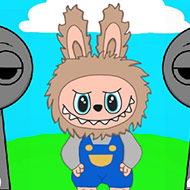
Sprunki, But It’s Labubu gives platformer fans something unfamiliar—a world that feels alive, reactive, and increasingly unstable. Every mechanic in this game is filtered through Labubu’s unpredictable nature, meaning players must treat every situation as a test of observation, not just skill. The further you go, the more Labubu’s influence distorts both your expectations and the path ahead.
Progression isn’t just about reaching the end of the level. It’s about unlocking and surviving transformation events. These can be triggered by simple actions: jumping five times in a specific pattern, dragging items across invisible zones, or interacting with walls that shouldn’t respond. The environment will then mutate—level geometry may shift, hazards might relocate, and your movement options change mid-run.
Power-ups in Sprunki, But It’s Labubu are unreliable. One mushroom might increase jump height temporarily, while another with the same appearance disables movement. Context matters: collecting a power-up too early may render it useless. Players must learn not to trust appearances, and instead observe how Labubu’s mood or location affects outcomes.
There’s no character menu or skin selector here. Instead, Sprunki, But It’s Labubu adjusts the appearance of Labubu based on how you play. Aggressive players might find him developing sharper teeth. Passive explorers may see Labubu’s model soften or stretch. The system builds a visual identity from your behavior, giving each player a unique imprint on the game world.
Sprunki, But It’s Labubu isn’t a test of patience—it’s a conversation between player and system. It rewards those who explore patterns without trying to control them. As Labubu shifts the world with each interaction, the game asks: can you stay flexible when everything familiar breaks apart?